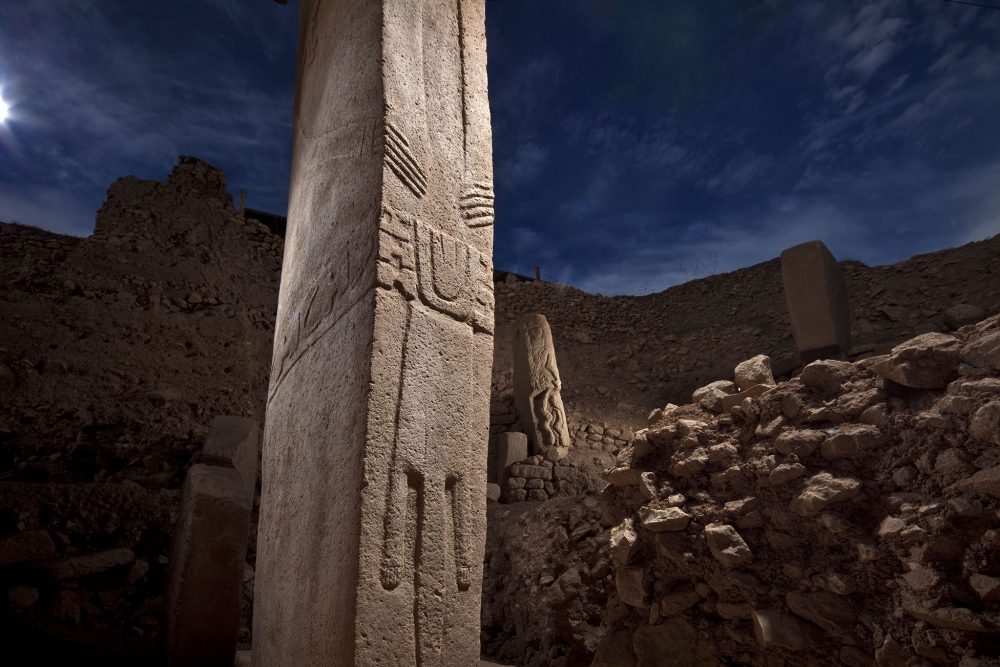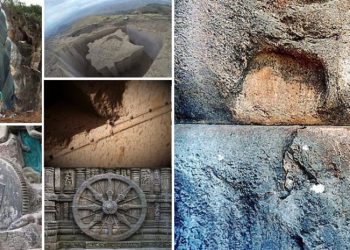Our whole map of early civilization has been turned upside down because high on a ridge in southeastern Turkey, a complex of stone pillars, some adorned with carvings, has been discovered and dated to roughly 9600-8200 BCE, some 11,000 years ago, at the beginning of the Holocene era, when farming and cities were still in the future. The carving, the pillars, the whole complex is older than farming, it is older than pottery, it is older than cities, and it is older, probably, than the wheel.
At present, the site consists of 20 circular and oval structures, some 30 meters in diameter, and many of the pillars are decorated with carvings of animals and humans, while a number of the pillars are sculpted into human-like figures. German archaeologist Klaus Schmidt and other experts have been excavating the site since 1994, and they have found no evidence of habitation, of people living at the site, nor have they found any evidence of domesticated plants or animals, of pottery, of metals, or any kind of tool associated with farming.
All they have are these magnificent buildings, which show every sign of being built to last, and that’s not all that’s odd, for when you look around the site, you see a landscape as barren as the moon, because the whole region has been scoured of trees, bushes, anything. In fact, the whole area is so devoid of trees that, when the Turkish government was looking for a place to build a dam, it chose the valley below the site, precisely because it didn’t have to chop down a million trees.
The temple seems to come first, because the site’s circular enclosures are made up of T-shaped pillars that bear crisp reliefs, such as foxes, snakes, vultures, and wild boar, and many pillars are stylized humans, with arms and hands, while two sit at the center of each ring, staring inward, like sentinels. The design is deliberate, and the symbolism is unmissable, and so, too, is what’s missing, for there are no houses, no hearths, no trash pits, and no evidence of daily domestic life, which suggests that this was not a settlement, but rather a place where people came for ritual, ceremony, and shared meaning.
In other words, hunter-gatherers organized at scale to create something bigger than survival, which flips an old assumption on its head, because monumental architecture was supposed to demand farms, surpluses, and hierarchy, but Göbekli Tepe shows the opposite may be true, and therefore, religion and cooperation may have compelled people to settle down and tinker with cultivation.
A massive project

Belief rather than barley may have constructed the world’s first communities, say researchers who have discovered that the landscape itself holds clues to that development, because the presence of wild grains and other foodstuffs in the region were previously thought to be the catalyst for the development of the world’s first communities, but findings reveal that the need to manage and feed large numbers of people brought together for monumental construction projects was a more likely driving force behind the development of the technology that allowed farming.
The researchers argue that large numbers of people were required to build structures like Göbekli Tepe, a 11,000 year-old stone temple in southern Turkey, and the labor required to construct these massive structures would have required the presence of hundreds of workers for many months. It has long been suspected that some other motivation may have driven people to domesticate plants and animals.
A study of the archaeological landscape at a number of sites in the Fertile Crescent found that wild wheat, barley, and legumes were widespread during the Pre-Pottery Neolithic period, some 11,500 to 10,500 years ago. The evidence suggests that such an enormous influx of people would have created a high demand for food and corporate labor to maintain the peace. This is when someexperts believe that domestication began to occur as a way of reorganizing labor — which would make the large construction possible — and of providing the food that would feed and maintain the labor force as well.
It’s possible that Göbekli Tepe was a sanctuary for seasonal rituals, or a place for initiations, or for honoring the dead, or a regional meeting place for societies structured around the movements of celestial bodies, but what’s certain is its power, because it brought people together for feasting, storytelling, and communing with their heritage. Around 8000 BCE, the builders did something that still astounds, because they buried the structure carefully, and the structures were systematically buried in fill layer by layer, entombing them in the earth for millennia to come, and perhaps this was due to new traditions, new ritual centers, or a changing world as the people turned from the hunter-gatherer lifestyle to one of cultivation.
We have excavated less than 10 percent of Göbekli Tepe, and the nearby Karahan Tepe and Sayburç, and other sites like them, hint at a much wider sacred landscape, which suggests that this was no singular wonder, but rather a web. Göbekli Tepe’s message is stark, because thousands of years before any writing, laws, or kings, people had the imaginative power — and the social will — to erect monuments that we now have no choice but to call art, and the first architecture is not just a shelter, it is a bond, and the people who built these pillars were not “primitives,” they were engineers of belief, and they changed us.











